タニヤ・プルースニック Tanja Prušnik
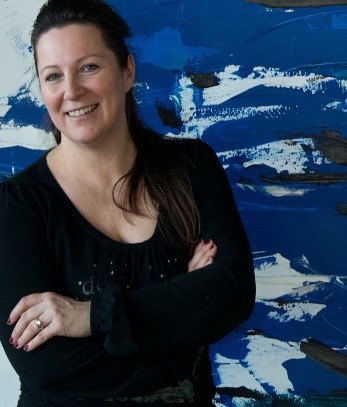
www.prusnik.com
1971-11-22 Born inWolfsbergu/Kärnten
1998 architecture degree at Vienna University of Technology
Since 1999 lives and works as freelance architect and artist in Austria – in Vienna, Carinthia and
Slovenia. Exhibitions Europe wide.
Since 2009 co-initiator and co-curator of DEN BLICK OEFFNEN, a social art project against violence
on children with exhibitions all over Austria to support children’s charities
Since 2014 member of the Austrian artists’ association, Künstlerhaus Vienna
Since 2016 member of artists association “likovno društvo Kranj”/ member of ZDSLU – united
artists association of Slovenian fine art artists /Zveza društev slovenskih umetnikov Slovenije
Since 2016 board of the Austrian fine art artists’ association, Künstlerhaus Vienna, Gesellschaft
bildender Künstlerinnen und Künstler Österreichs
Since 2018 member board of gremium of Culture Committee Carinthia
Since 06/2019 first female president of the Austrian artists’ association, Künstlerhaus Vienna,
founded in 1861
from 2021 – 2023 board curator of first Carinthian Cultural Foundation
2021 – 2024 curator and artistic director of art festival millstART in Millstatt Carinthia/A
Since 2022 curator in Slovenia for ART Circle Goriška Brda nominated by Austrian Embassy
Since 2024 „Art at the power station“: curator and creator of exhibition series
water.light.air.power. for KELAG / Carinthia/A
Awards
2004 »Pro Kultur&Kontra Gewalt” Women´s Art Prize 2004, Carinthia/A
2005 residency of the City Vienna
2016 residency in Šmartno/Slovenia of the City Klagenfurt/Carinthia/A
2019 Human rights award from Country Council Carinthia/A for the art project DEN BLICK ÖFFNEN
2022 Honorable Grand Medal of the Country Council Carinthi/A
Over 200 Solo and joint exhibitions, over 60 simposia, art workshops and several curatings of international exhibitions europewide. Public collections: St. Veit Town Council, Austrian Parliament, Wolfsberg Municipal Buildings, Carinthia, several private collections. Cover Pages on several book publications.
Curating projects: since 2009 den blick öffnen (social-art project, co-curator, over 20 exhibitions: Klagenfurt, Salzburg/Berchtoldvilla, Wr. Neustadt/City gallery; Vienna/Künstlerhaus, Kro Art Contemporary, international Art Fair WIKAM 2012 – 2020
Artists e.g.: Hermann Nitsch, Gottfried Helnwein, etc.); 2021, 2022 Naša Koroška and Koroška unser (Klagenfurt/Kunstverein, k&k center; Styria/ Pavelhaus); Wasser_water Kro Art Contemporary Vienna (co-curator); 2018 time space existance for Venice Biennale side programme ECC), 2023 Longing for Future (7 architects) for Venice Biennale side programme ECC;
2024 and 2025 Art at the PowerStation: SCHAU.KRAFT.WERK _ Wasser.Licht.Luft.Kraft. for Kelag Carinthia; 2024 Martin Roth: or what we have made of our environment and how we have tamed it Künstlerhaus Factory; 2024 Longing for Future (7 architects and friends of Künstlerhaus) in Rome Austrian Culture Forum, »Longing for Future« as special exhibition of Gangwon Triennale 2024 in Chuncheon and Pyeonchang/South Korea, etc.
Landart and public space:
2020 Installation on bridge at Lavamünd/Neuhaus (Carinthia, A), as part of the Carinthian juilee Exhibition 2020 CarinthiJA
. 1920.2020_UTOPIA gnp2 Peršman Museum: Landart project over 10 kilometers (art piece) as part of the Carinthian juilee Exhibition 2020 CarinthiJA
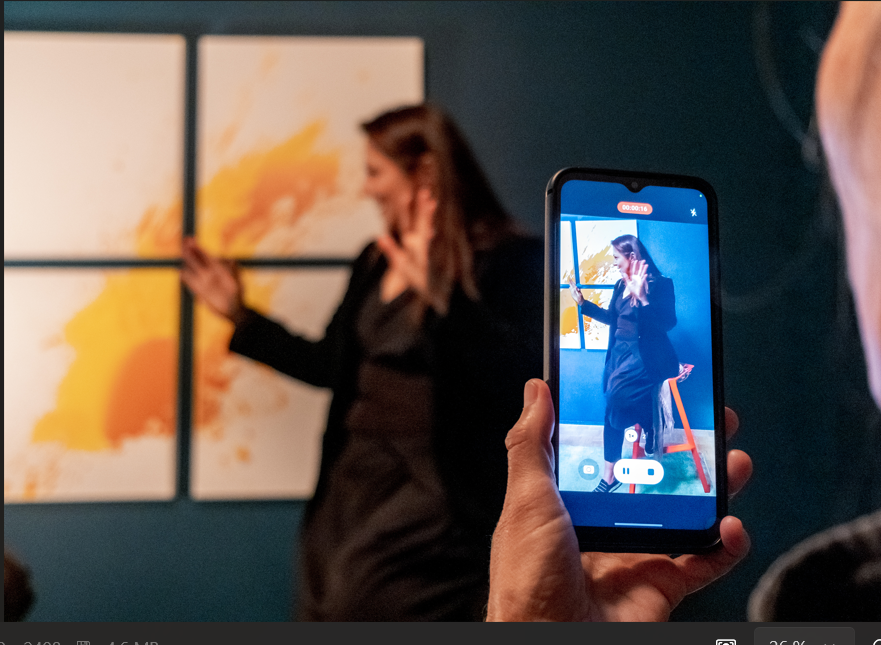
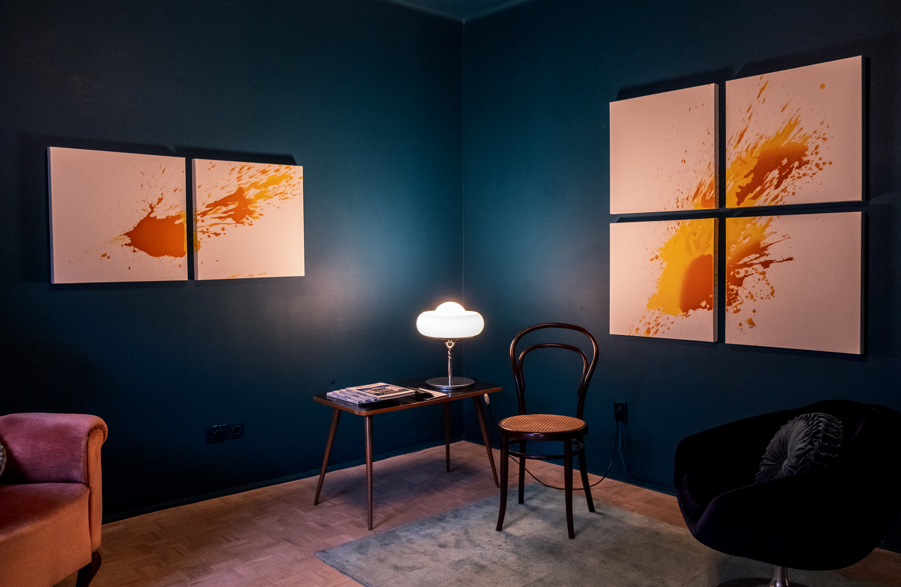
exhibition views, Alma gallery medana/Slo, Tanja Prušnik – Colour Blockings, 2023

©Tanja Prušnik, from the series colour blockings: “yellow”, 2023, ink on canvas, 60 cm x 120 cm

©Tanja Prušnik, from the series colour blockings, 2023, ink on canvas, 120 x 120 cm and 60 x 60 cm, Photo Oskar Kandare


©Tanja Prušnik, from Series “liquids_sun”, 2022, 8 x 8 x 8cm, painting objects, yellow ink on canvas
The works from the “Yellow” series in the current exhibition “colour blockings” allow you to immerse yourself in an invigorating “bath” in yellow. The reduction to a single gestural application and the visual experience of depth with just a single colour leave the viewer with special traces and experiences.
Powerful dynamics, process-like gestures and image compositional bravura are the focus of the observation. The background sometimes dissolves. The works, which for the artist also have a transitory component, were created in different locations and through changing studio situations.
They allow the quick, concentrated work to be seen as a play with color, space and depth, as well as the fields of tension that are inherent in the work, including yellow, blue, black and red, which explode explosively against a dark or white background. (Kultur/Krone, 3.8.20/23)


©Tanja Prušnik, from the series colour blockings: “yellow 2” and “yellow 3”, 2022, 60 x 60 cm, yellow ink on black canvas

Exhibition view ©Tanja Prušnik, from the series colour blockings „yellow“, 2023

©Tanja Prušnik, „blu“, 2023, Ø 50 cm, blue ink on canvas

©Tanja Prušnik, LUČe, 2024, light object, 100 x 150 x 8 cm
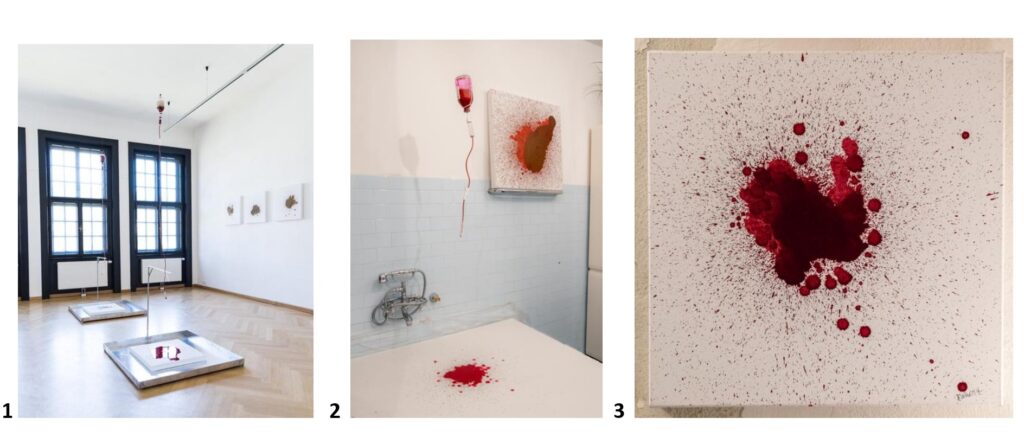
From the series: esce o.l./blood_rdeče, ©Tanja Prušnik
1 Exhibition view, Künstlerhaus Klagenfurt “rdeče”, photo: Arnold Pöschl
2 Exhibition view – Alma Gallery Medana/SLO
3 “esce.o.l. rdeče (blood”), 2017, 40 × 40 cm, red ink on canvas
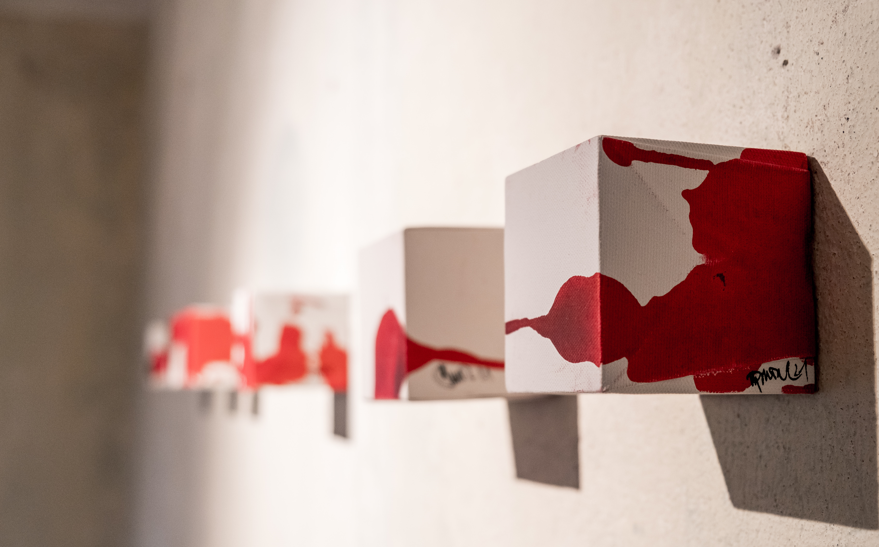
©Tanja Prušnik, “RED 1– 4”, 2022, 8 x 8 x 8 cm (each), red ink on canvas
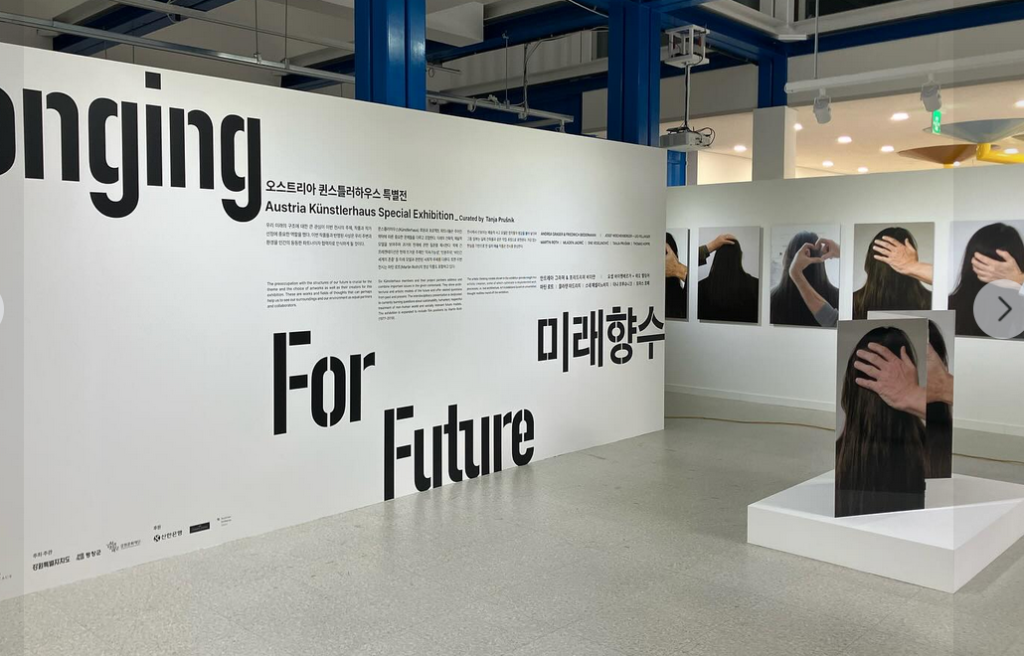
Longing for Future 2024 (Chuncheon, KangWon National University Art Museum / Pyeongchang, Space Changgong)
Exhibition view, Pyeongchang (Space Changgong) – ©Tanja Prušnik, “Stummer Diener seiner Herrin?”, 100 x 150 cm, Alu Dibond Photoprints; “SPmH 1-5”, 90 x 70 cm Alu Dibond Photoprints

Atelier view at residence IKUH ART, 2024, Awaji Island, Japan, diverse paintings (ink on japanese paper; fan objects, installation objects: glazed, seawater shaped rooftiles, steel
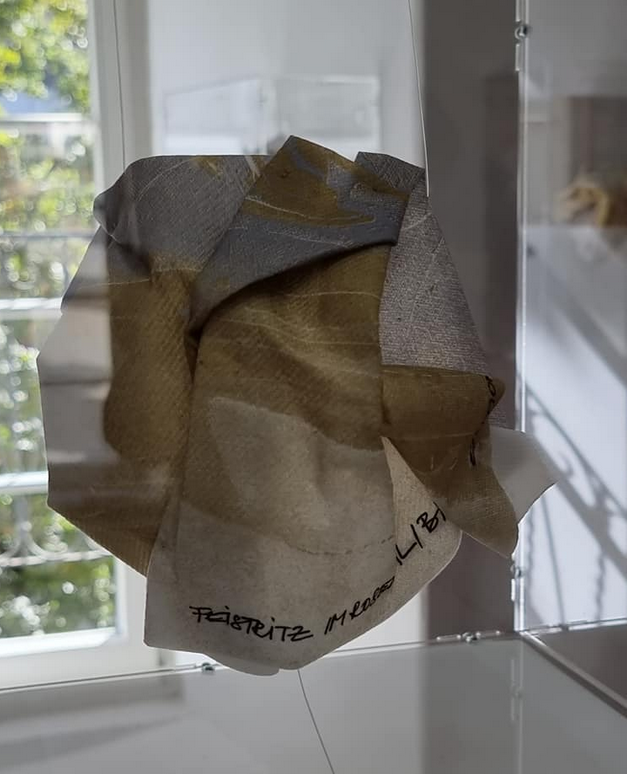
©Tanja Prušnik, C-unst Masken (Corona art Masks), 2021 object, cellulose in origami folding technique in acrylic box, 50 x 40 x 12 cm
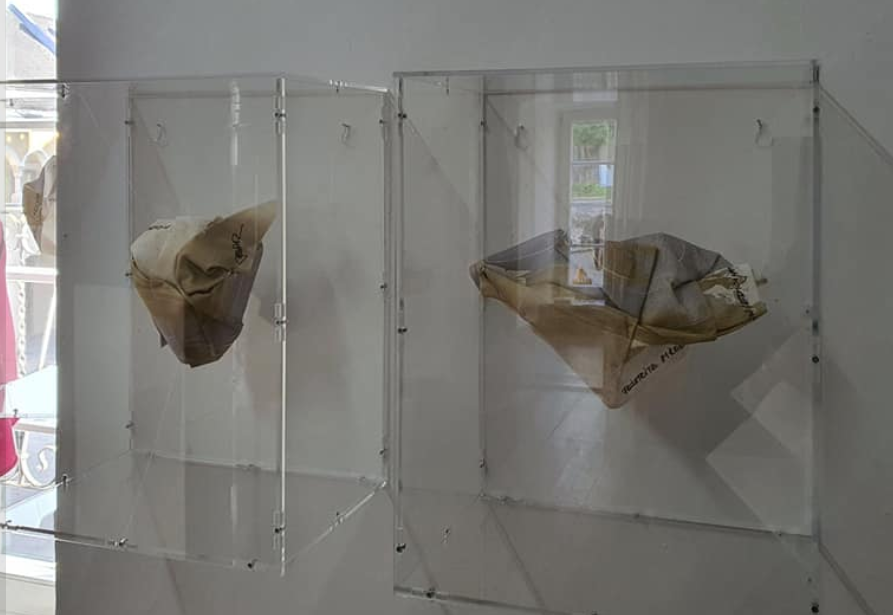
©Tanja Prušnik, C-unst Masken (Corona art Masks), 2021, object, cellulose origami folding technique in acrylic box, ea. 50 x 40 x 12 cm ; exhibition view

©Tanja Prušnik, “Spuren 1-4”, ea. 50 x 70 cm, acryl on acrylic foil, 2023
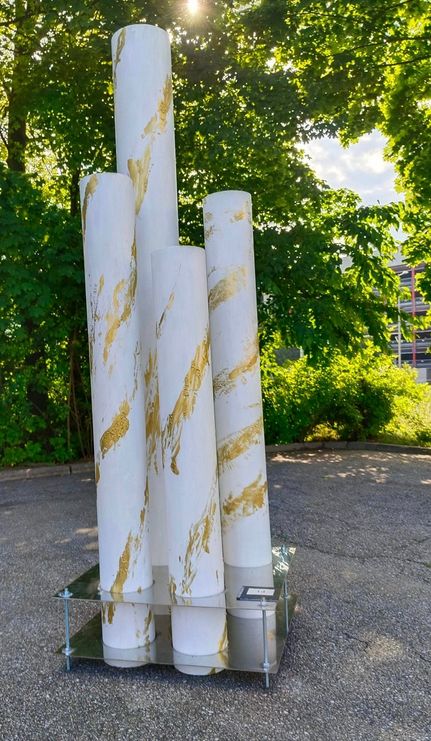
©Tanja Prušnik, sculpture, acrylic on polokal, niro, 250 cm x 100 x 100 cm
About the immediacy of the image – on Tanja Prušnik’s work
Things she has seen, atmospheres, landscapes, urban architecture as well as political issues and literature are the starting points for Tanja Prušnik’s body of paintings. However, the representation of motifs in the artist’s paintings goes beyond a literary or documentary viewpoint. Rather, they are translated into an abstract formal repertoire. The objects are no longer naturalistic and illustrative, colouring becomes more important and the brush stroke is almost impossible to describe. The motif is used merely as a stimulus for the overall painting process. The picture itself is non-objective, but remains open for associations. Tanja Prušnik develops a new world on the canvas, a world that is not in contradiction with nature, but tries to examine the origins of any composition using the possibilities of art and move these basic elements of nature onto another, maybe unusual level. Her work is positioned at a special junction, combining two very different systems – the system of nature and the system of painting. The reception of nature takes place both before and during the actual painting process, but it never deteriorates into a banal or even romantic description. It is evident that this is best achieved by using reduced forms as in this dialogue between perception and form, priority is given to the artist’s creative process. Painting becomes a means to visualize the atmosphere of reality. It provides the possibility “to see what is special, which in turn can only hope to be seen.“[1] Maybe even in line with Paul Celan, who considered his poems as gifts to the attentive.[2]
While Tanja Prušnik concentrated on urban architecture in her earlier series, her newer works from the recent years have focused on natural elements while using the same tectonic colour structure as in the urban series. The same holds true for the tension between white canvas and the colour she applies in opaque, at times even thick layers. She generally uses only few colours, which, based on the specific subject of the series, characterise it and merge it to a single unit. In doing so, she has constantly crossed the borders of panel painting: first by using the medium of assemblage, in which she included elements from nature on the canvas, later, in her current works, by developing her canvases into installations or architectural constructions. The two-dimensional picture surface becomes a three-dimensional object. The way the object is positioned in the room virtually demands for the viewer to move. The pictures are intended to be passed through, the viewer can and should move around within the installation. Thus, paintings become objects. This applies in particular to the artist’s picture-steles. It is part of the concept that the canvases are piled up and not all paintings are fully visible. In these pieces of pictorial architecture, the back of the pictures is visible as well and the real paintings can be seen only when looking into the interspaces. “With her pictorial architecture, Tanja Prušnik creates an almost infinite variability of appearances for her pictorial objects – every viewer needs to develop their own form of perception and manifestation “, says Erwin Fiala about the artist’s works.[3]
The pictures recount the dialogue between an external and an internal reality. Eventually, the search for an adequate form of representation needs to lead into a detachment from the picture as defined in literature. Faced with both nature and her urban surroundings, the artist has begun to detach herself from the traditional notion of a picture. It is no longer supposed to denote or narrate, but rather directly depict what it really is. The impressions of nature – the collision of differently coloured fields, rays of light that touch a furrow or the water surface – turn into a pure discourse of colours. What is at work here is the translation of nature into a pictorial form beyond representation and narration. It is evident that Tanja Prušnik’s painting lacks any kind of illusionistic depth. This is, in fact, not the point. Everything is in the background and at the fore at the same time, positioned side by side and at the same time on top of each other. The real dialogue between the artist and nature is held on the canvas, where the model meets pure form, where perceived emotions and experiences are transferred without using colour as a descriptive element. The artist objectifies and isolates nature by translating it into a reduction of colour. At the same time, she recognises it as an instance, which is definitely something else than the search for a motif. What happens between the furrows of a field is now a dualism of colour surfaces. How does the yellow change if some green is applied alongside, what happens on the colour surface if dark and light colours are applied adjacently? The picture starts to oscillate and develop new shades.
Tanja Prušnik’s pictures are always part of process-oriented series, on which she usually works in parallel and simultaneously. They are linked in their frontality of representation. The artist approaches the things she depicts without giving them the possibility of gaining imaginary depth, which does not mean that they do not possess a spatial dimension. However, space in her pictures is not generated from perspective, illusionism or a play of light and shadow, but merely from the correlation of form and colours. The artist skilfully combines the white canvas with a gestural, fast and pastose application of paint, as if she wanted to introduce the viewer to the antagonisms and the fragility of life by focusing on the contrast of openness and the presence of colours.
The question of time and movement is immanent to the pictures, although the calm homogeneous white surface and the gestural movement alternate constantly, as if the artist wanted to intensify our ability to see. But what constitutes the temporality and the movement of the pictures? They do not follow any internal logic of before and after, rather, their temporal characteristics are constituted by the picture itself. However, the transition to a spatial and temporal succession takes place as soon as the individual shapes are seen as a whole and move closer to the boundaries of what can only be imagined and not described anymore. Thus, the viewer’s perception is constantly being pushed into different directions. The viewing experience changes continuously, providing all possibilities for interpretation at all times, but never simultaneously. Which leads us back to reality and its diverging perceptions as well as the supra-temporality that is characteristic for the picture itself.
The colour on the painting support represents one of many layers that go beyond the border of painting as well. This is how she mixes up transparent colour with an opaque colour surface. Furthermore, there are haptic structures in places where the colours densify. Depending on the glaze, the colour surfaces are darker or lighter and therefore raise the gestural structure to a certain level. During the process of painting, the artist’s intention quickly changes from motif-based stimulation to a pure examination of typical issues of painting such as shape, colour and surface. At that point, Tanja Prušnik no longer works on the motifs of nature, but on the reality of the picture itself, and tries to examine the phenomena of colour, explore them and work on the possibilities of their materiality. Her works, which she usually assembles in series, are characterised by a profound knowledge of materials and a very secure brush stroke. It almost seems as if the artist’s gestural colouring took its own steps and continued them from one picture to the other, like a musical rhythm. This easiness and the implicitness of the brush stroke create a continuous oscillation throughout the series. In her pictures, Prušnik uses disruptive and explosive gestures on the one hand, and poetic and lyrical tones on the other.
The knowledge about constantly changing realities of space and reality are a prerequisite to transfer time and change onto the surface of a static medium. By readopting and continuing the same formal idea, this change becomes portrayable. Due to the artist’s characteristic combination of a powerful, expressive graphic and the use of only few colours in a vast variety of shades, corresponding to the topic of the series, the pictures evoke a certain pausing in the viewer before they may even more intensely immerse themselves into the movement and the space of her pictures. Her painting is positioned far from the actual motif. Even if the viewer seems to recognise some things, Tanja Prušnik remains informal. There is something enigmatic about her pictures, something that – as Markus Lüpertz puts it – basically represents an artist’s passionate motivation, because they like to be there “to handle the situation of the incalculable.”[4]
(Silvie Aigner)
[1] Markus Lüpertz, Der Kunst die Regeln geben, A conversation with Heinrich Hell, Zürich 2005, p. 124
[2] Paul Celan, letter to Hans Bender, in: Paul Celan, Collected Prose, New York 2003. p.26
[3] http://www.styrianart.at/st_art/galerie/tanja-prusnik/
[4] Lüpertz, 2005, p. 39